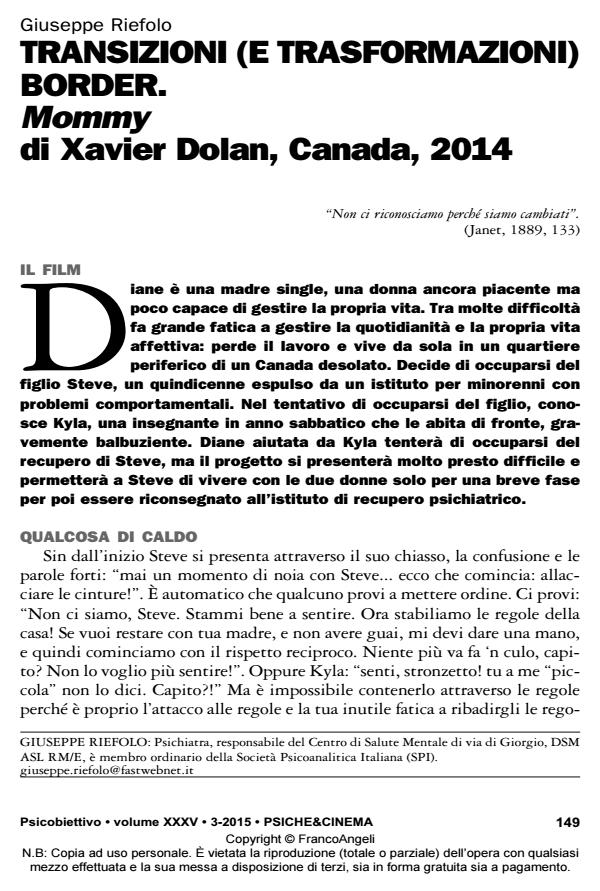Transizioni (e trasformazioni) border. Mommy di Xavier Dolan, Canada, 2014
Titolo Rivista PSICOBIETTIVO
Autori/Curatori Giuseppe Riefolo
Anno di pubblicazione 2016 Fascicolo 2015/3
Lingua Italiano Numero pagine 11 P. 149-159 Dimensione file 104 KB
DOI 10.3280/PSOB2015-003011
Il DOI è il codice a barre della proprietà intellettuale: per saperne di più
clicca qui
Qui sotto puoi vedere in anteprima la prima pagina di questo articolo.
Se questo articolo ti interessa, lo puoi acquistare (e scaricare in formato pdf) seguendo le facili indicazioni per acquistare il download credit. Acquista Download Credits per scaricare questo Articolo in formato PDF

FrancoAngeli è membro della Publishers International Linking Association, Inc (PILA)associazione indipendente e non profit per facilitare (attraverso i servizi tecnologici implementati da CrossRef.org) l’accesso degli studiosi ai contenuti digitali nelle pubblicazioni professionali e scientifiche
Il film Mommy (Dolan, 2014) permette una serie di interrogativi che riguardano la clinica dei pazienti borderline. Il problema che pongono questi pazienti concerne la dissociazione difensiva netta fra gli oggetti concreti e gli affetti. Tutto il comportamento patologico del border si concentra sulla necessità di coprire e negare il netto bisogno di sperimentare emozioni. Tale esperienza è continuamente cercata, ma al tempo stesso temuta perché coincide con il riconoscimento dei limiti e delle fragilità che questo tipo di pazienti non possono riconoscersi. Pertanto Kyla che nel film balbetta evoca il tentativo dei border di presentare la propria voce, costantemente coperta dal chiasso. La grandiosità esasperata che i border propongono continuamente copre il diritto di questi pazienti di poter presentare le proprie ferite che, nella realtà, permette l’esperienza dolorosa, ma autentica della vergogna. Ma Steve che si vergogna vorrebbe trovare riconoscimento, mentre trova indifferenza. Infine il film suggerisce che i percorsi di cura di questi pazienti hanno esiti molto differenti e, quasi sempre limitati a fasi più o meno lunghe che lasciano sempre percorsi sospesi o drammaticamente interrotti.
Parole chiave:Borderline; cinema e psicoanalisi; adolescenza; dissociazione; processo dissociativo; vergogna.
Giuseppe Riefolo, Transizioni (e trasformazioni) border. Mommy di Xavier Dolan, Canada, 2014 in "PSICOBIETTIVO" 3/2015, pp 149-159, DOI: 10.3280/PSOB2015-003011